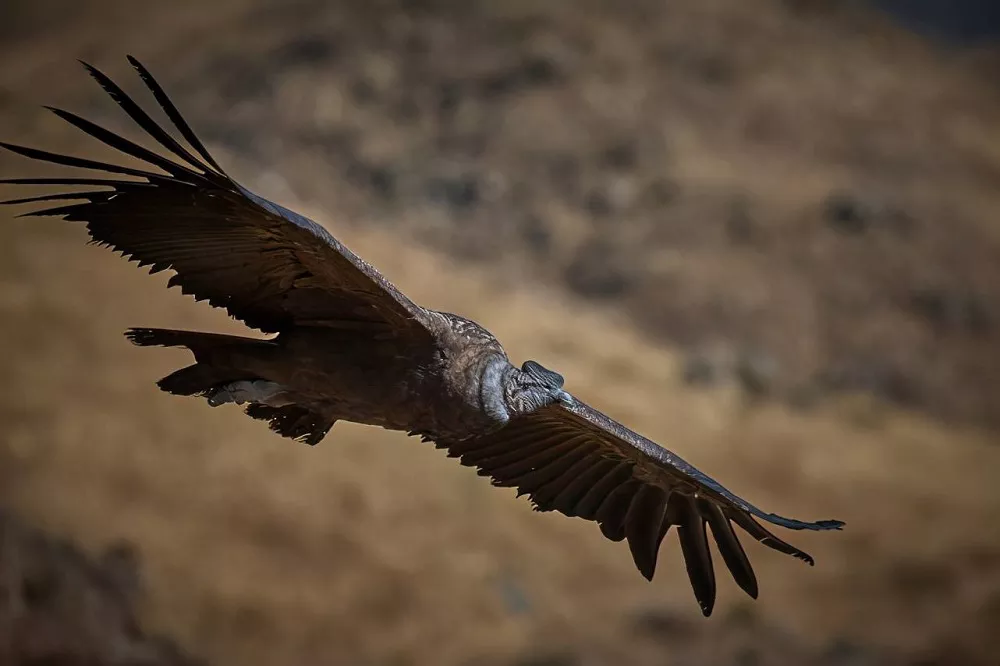The Andean Condor (Vultur gryphus) is one of the largest flying birds in the world and an iconic symbol of the Andean mountain range in South America. Known for its impressive size, magnificent wingspan, and distinctive appearance, the Andean Condor holds a significant cultural and ecological significance in its native habitat. In this article, we will explore the characteristics, behavior, conservation status, and importance of the Andean Condor.
Physical Characteristics:
The Andean Condor is a remarkable bird with a wingspan that can reach up to 3 meters (9.8 feet), making it one of the largest flying birds on Earth. Adult males can weigh up to 15 kilograms (33 pounds), while females are slightly smaller. They have a unique and striking appearance, featuring black feathers with white patches on the wings and a ruff of white feathers around the neck. Their bare head and neck are adorned with wrinkled skin that can change color depending on their mood.
Habitat and Range:
The Andean Condor is found in the high mountainous regions of the Andes, spanning from Venezuela and Colombia in the north to Chile and Argentina in the south. They inhabit a variety of habitats, including rugged mountains, cliffs, canyons, and open grasslands. These birds are well-adapted to the challenging conditions of high altitude and are often seen soaring effortlessly on thermal air currents.
Behavior and Diet:
Andean Condors are primarily scavengers, feeding on carrion (dead animals) that they locate using their excellent eyesight and keen sense of smell. They play a crucial ecological role by removing decaying animal carcasses, thereby preventing the spread of diseases and maintaining a healthy ecosystem. These birds are not equipped with strong beaks for tearing flesh, so they rely on their powerful neck muscles to rip apart carcasses and feed on the soft tissues.
Breeding and Reproduction:
Andean Condors are monogamous and form long-term pair bonds. They build large nests in rock crevices, cliffs, or trees, where the female lays a single egg. Both parents take turns incubating the egg and caring for the chick, which hatches after approximately two months. The young condor remains dependent on its parents for an extended period, taking several years to mature and develop their iconic adult plumage.
Conservation Status:
The Andean Condor is listed as “Near Threatened” on the International Union for Conservation of Nature (IUCN) Red List. The primary threats to their population include habitat loss, human disturbance, poisoning from lead ammunition in carcasses, and illegal hunting. Conservation efforts, including habitat protection, captive breeding programs, and public awareness campaigns, are crucial for their long-term survival.
Cultural Significance:
The Andean Condor holds significant cultural and symbolic importance in the Andean cultures of South America. It is revered as a sacred bird and often represents power, wisdom, and the spiritual world. The bird’s majestic presence in the Andean landscapes has inspired many legends, artworks, and traditional ceremonies.
Conclusion:
The Andean Condor is an awe-inspiring and majestic bird, symbolizing the grandeur of the Andes and the rich biodiversity of South America. With its impressive size, distinctive appearance, and crucial ecological role as a scavenger, the Andean Condor holds both cultural and ecological significance. Conservation efforts are necessary to protect this magnificent species and ensure its continued survival in its natural habitat. By appreciating and safeguarding the Andean Condor, we contribute to the preservation of a true icon of the Andean mountains.


 Facebook
Facebook  Instagram
Instagram  Youtube
Youtube 